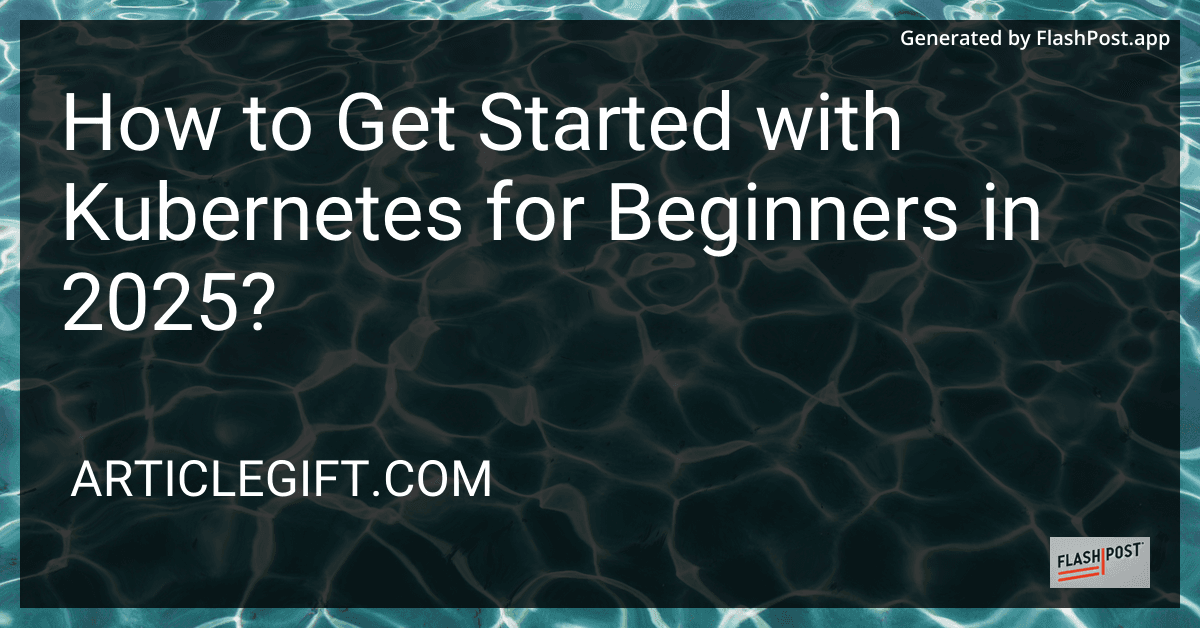Best Kubernetes Learning Resources for Beginners in 2025 in December 2025

The Kubernetes Book



Kubernetes: Up and Running: Dive into the Future of Infrastructure



Kubernetes in Action



Certified Kubernetes Administrator (CKA) Study Guide: In-Depth Guidance and Practice



The Book of Kubernetes: A Complete Guide to Container Orchestration



The Kubernetes Bible: The definitive guide to deploying and managing Kubernetes across cloud and on-prem environments



Cloud Native DevOps with Kubernetes: Building, Deploying, and Scaling Modern Applications in the Cloud



Cracking the Kubernetes Interview: Discover expert tips and best practices to ace your Kubernetes technical interviews


If you’re stepping into the world of container orchestration, there’s no doubt that Kubernetes is a name you’ve encountered. As of 2025, Kubernetes continues to be the top choice for managing containerized applications at scale. This beginner’s guide will help you understand the basics of Kubernetes and how to get started with it.
What is Kubernetes?
Kubernetes, often abbreviated as K8s, is an open-source platform designed to automate the deployment, scaling, and management of containerized applications. Originally developed by Google and now maintained by the Cloud Native Computing Foundation (CNCF), Kubernetes provides a robust framework for running distributed systems resiliently.
Key Concepts in Kubernetes
Before diving into the setup, let’s cover some essential concepts:
-
Cluster: The foundational structure of Kubernetes, consisting of nodes (machines) that run your containerized applications.
-
Pod: The smallest deployable units in Kubernetes, typically encompassing one or more containers. Pods share the same network and storage resources.
-
Service: An abstraction that defines a logical set of pods and a policy to access them, often via a stable IP address or DNS.
-
Namespace: A way to divide cluster resources between multiple users, allowing for isolation of environments.
Getting Started with Kubernetes
1. Install a Kubernetes Cluster
To start using Kubernetes, you’ll need a cluster. For beginners, Minikube is an excellent option. It runs a single-node Kubernetes cluster on your local machine, allowing you to experiment in a controlled environment without cost.
To install Minikube:
-
Install Docker: Minikube requires Docker as a runtime for containers.
-
Download Minikube: Download the latest Minikube from their official site.
-
Start Minikube: Launch a Kubernetes cluster using the command:
minikube start
2. Learn Basic Kubernetes Commands
Familiarize yourself with kubectl, the command-line tool for interacting with your cluster. It’s essential for managing Kubernetes resources.
Some commonly used commands include:
- Get Cluster Info:
kubectl cluster-info - List Pods:
kubectl get pods - See the Containers Running: Learn more about how to list containers in Kubernetes.
For a comprehensive guide on commands in 2025, check out Kubernetes kubectl commands 2025.
3. Deploy Your First Application
Test your setup by deploying an application. For example, you can deploy a simple Nginx server:
kubectl create deployment nginx --image=nginx kubectl expose deployment nginx --port=80 --type=NodePort kubectl get pod,svc
Visit your newly running application by accessing the Minikube IP.
4. Monitor Your Cluster
Monitoring your Kubernetes cluster is crucial to ensure the smooth operation of your applications. In 2025, several tools can help you achieve this, such as Prometheus, Grafana, and newer solutions. For a detailed look into monitoring tools, visit Kubernetes Monitoring Tools 2025.
Conclusion
Kubernetes can seem daunting at first, but by understanding its core concepts and practicing in a local environment like Minikube, beginners can build a solid foundation. As you become more comfortable, consider exploring advanced topics like networking, scaling, and security within Kubernetes clusters.
Don’t forget to utilize resources and communities that share up-to-date information and trends. By continuously learning and experimenting, you’ll become proficient in managing Kubernetes clusters.
Whether you’re an aspiring DevOps engineer or a developer looking to streamline application deployment, Kubernetes has the power to transform your workflows and ensure confident, reliable software delivery. Happy Kuberneting!
